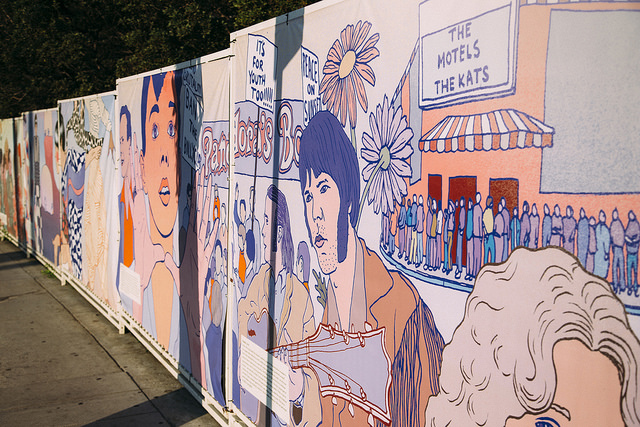
West Hollywood’s Arts Division has installed “A Mecca of Bold, Retold,” a 140-foot-long temporary mural by Aaron Glasson that highlights some of the historic figures and significant events in the city’s history. This mural is located at William S. Hart Park at 8341 DeLongpre Ave. and can be viewed facing Sunset Boulevard on the Sunset Strip.
Scheduled to be displayed through December 2018, the mural features the history of West Hollywood, which is rich with artistic, progressive and creative personalities including activists, actors, producers and poets, and highlights some of the city’s significant milestones and events. The artwork was commissioned in celebration of the “Summer on Sunset: A Tribute to the Summer of Love” events promoted by the West Hollywood Travel + Tourism Board, which is the visitors bureau of the City of West Hollywood.
The first six panels of the mural are an acknowledgement to the Tongva Native Americans, who inhabited the Los Angeles Basin and the Southern Channel Islands pre-colonization, as well as a nod to Moses Sherman and his most recognized achievement, the Los Angeles Pacific Railroad. Sherman was also the founder of the area of Sherman, which is now known as the City of West Hollywood. The historic brick four-story structure illustrated in the artwork represents the La Fontaine. That building was constructed in 1928 and is representative of a significant pattern of new high-density luxurious developments in the area around Fountain Avenue in West Hollywood.
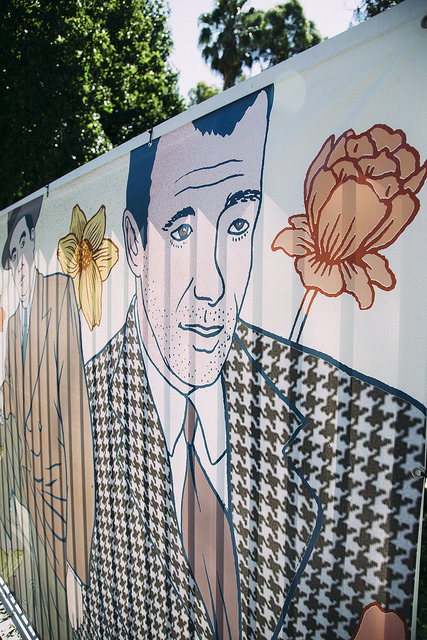
The seventh panel recognizes the evolution of the area during the silent film era. Notably, Russian immigrant Allah Nazimova represents the height of silent film popularity. Her mansion, The Garden of Allah, was located in the City of Los Angeles, just outside of West Hollywood’s border on Sunset Boulevard. Nazimova wielded considerable influence and power in Hollywood as an artist, was bisexual and was famous in Hollywood for her women-only pool parties held at her estate. Creatives such as Nazimova were early trailblazers who set a precedent that attracted other like-minded progressive artists and activists.
Panel eight takes one to the time of Prohibition, when the Sunset Strip was the destination of choice for movie stars, big-time writers and entertainers who frequented the popular nightclubs and speakeasies. Gangsters such as Bugsy Siegel and Mickey Cohen patronized restaurants like Ciro’s and the Sunset Trocadero. And it was not unusual to hear the notes of John Coltrane’s trumpet drifting through the air from the jazz clubs like Club Renaissance.
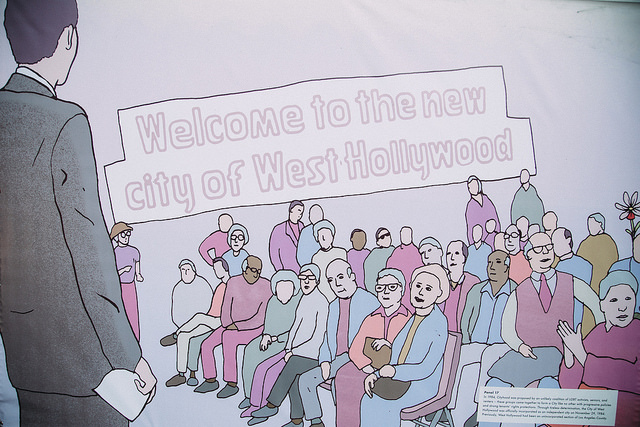
The work of West Hollywood resident, poet, writer, critic and screenwriter Dorothy Parker is celebrated in panel nine. She was a vocal advocate and defender of human and civil rights. Parker was a charter member of the Algonquin Round Table, a group of writers, critics, actors and wits who often collaborated with one another and acquired national reputations for their contributions to literature. A champion of social justice, Parker bequeathed her estate to Martin Luther King Jr., and upon his assassination some months later, the estate, which included Parker’s literary rights, was turned over to the NAACP.
Panel ten introduces Mary Pickford and Douglas Fairbanks, who founded the Pickford-Fairbanks Studios in 1919 at the corner of Santa Monica Boulevard and North Formosa Avenue. Later, with new partners Charlie Chaplin and David Wark Griffith, the studio was renamed the United Artists Studio, which was established to allow actors to control their own interests, rather than being dependent on commercial studios. One of United Artists most successful endeavors was 1953’s “The Joe Louis Story.” The movie studio compound has been known as The Lot since 1999, and is home to OWN – The Oprah Winfrey Network.
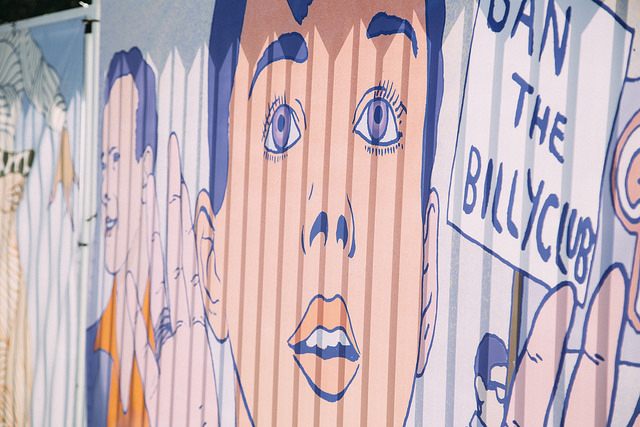
Avant-garde clothing designer Rudi Gernreich’s clothes are regarded by some as the most innovative and dynamic fashion of the 1960s. He consciously pushed the boundaries of acceptable fashion and used his designs as an opportunity to comment on social issues and to expand society’s perception of what was acceptable. He was the first to introduce unisex designs and cutouts in clothing. He designed the first thong bathing suit, the first swimsuit without a built-in bra, and the topless “monokini.” Gernreich, with his then lover Harry Hay, co-founded the Mattachine Society, one of the earliest LGBT gay rights organizations in the United States, to improve the rights of gay men. Gernreich lived together in West Hollywood with his partner Oreste Pucciani, also a pivotal figure in the gay rights movement, until his death in 1985. They are celebrated in panels 11 and 12.
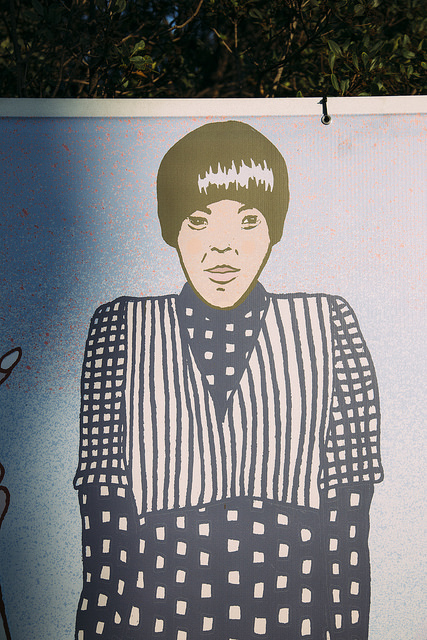
Panel 13 combines an icon and an activist. Henry “Harry” Hay, Jr. was a prominent American gay rights activist and civil rights campaigner. Hay has been described by author Stuart Timmons as the “Founder of the Modern Gay Movement.” In 1989, the West Hollywood City Council presented a proclamation to Harry Hay for his 77th birthday, naming him as “Honorary Citizen of West Hollywood.” Actress and singer Judy Garland once lived just north of the Sunset Strip. Garland had a large fan base in the gay community and is widely recognized today as an icon among gay men. She is famous for her role as Dorothy Gale in “The Wizard of Oz” (1939) and was the first woman to win the Grammy Award for Album of the Year for her live recording “Judy at Carnegie Hall” (1961).
Panel 14 takes us to the 1960s, when the Sunset Strip became a gathering place for the counterculture movement in Los Angeles and outbursts of social, creative and artistic freedom sporadically erupted. Rock and roll dominated the music scene, and notable musicians like Janis Joplin, Jim Morrison and Jimi Hendrix were fixtures at the clubs. The Whisky a Go Go was the first to introduce go-go dancers to the U.S. and the club that propelled The Doors — the club’s house band at the time — into fame and notoriety. The Sunset Strip curfew riots erupted in 1966 in front of Pandora’s Box, where as many as 1,000 demonstrators, including celebrities Jack Nicholson and Peter Fonda, protested against the City of Los Angeles’ new curfew and loitering laws. The riots inspired multiple songs including “For What It’s Worth” written by Stephen Stills and performed by Buffalo Springfield.
Panel 15 reminds us that from the late 1960s and into the 1980s the Sunset Strip was temporarily transformed into the world’s largest drive-through art gallery. Billboards, giant temporary monuments, were hand-painted homages to rock music. Depicting the latest album covers of the world’s top recording artists, ranging from the Beatles and Bowie to The Who and Led Zeppelin, the billboards’ visuals dominated the Strip and redefined outdoor advertising. The billboards were photographed by Robert Landau and published as a book in 2012. Large scale reproductions of the photographs are currently on exhibit through October 2018 at the city parking lot near the old Tower Records store, located at 8775 Sunset Blvd.
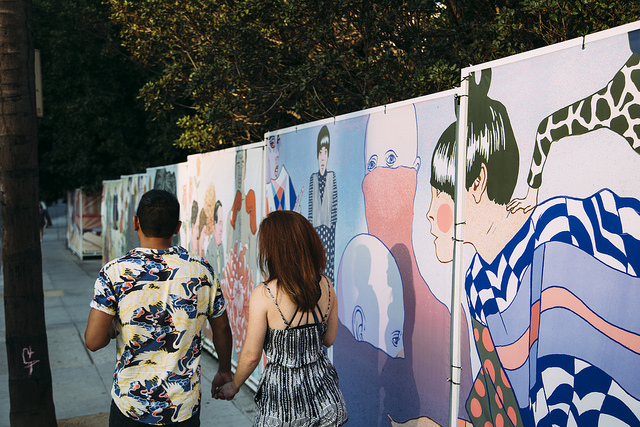
Panel 16 highlights the early days of the gay rights movement. While not brought to the forefront of national consciousness, the LGBTQ community in Los Angeles experienced the first gay-rights protests after officers beat gay patrons and arrested 14 people for same-sex kissing at the Black Cat bar on New Year’s Day in 1967. The first L.A. Pride Parade was organized in 1970 by Christopher Street West to commemorate the 1969 Stonewall riots, an uprising triggered by a police raid of a gay bar in New York City located on Christopher Street. The fight over an anti-gay sign (“Fagots (sic) Stay Out”) at Barney’s Beanery on Holloway was the focus of the first major protest by the Los Angeles Gay Liberation Front, which was co-founded by Morris Kight.
Panel 17 takes us to 1984, when cityhood was proposed by an unlikely coalition of LGBT activists, seniors and renters. These groups came together to form a city with progressive policies and strong tenants’ rights protections. The City of West Hollywood was officially incorporated as an independent city on November 29, 1984. Previously, West Hollywood had been an unincorporated section of Los Angeles County.
Panel 18 takes us from L.A. Pride to the Resist March. Morris Kight, was an American gay rights pioneer and peace activist. He is considered one of the original founders of the gay and lesbian civil rights movement in the United States and co-founded what was then known as the Los Angeles Gay and Lesbian Community Services Center. Kight regularly visited the Matthew Shepard Human Rights Triangle in West Hollywood to tidy up the area, water and plant new flowers, and he encouraged others to do the same. In 2017, the colorful floats that were typically seen in the Pride Parade were replaced with people marching for human rights. The Resist March, harkening back to the roots of the original Pride Parade, was a demonstration of fighting for human rights, inspired by the massive women’s marches that took place across the globe the day after President Trump’s inauguration.
Panel 19 illustrates that today’s Sunset Strip continues to be a place where art and innovation intertwine in ever-evolving ways. The grit of the rock scene from yesteryear is undergoing a transformation to an ambiance that is decidedly upscale. You can still visit several of the iconic establishments on Sunset Boulevard on the new City of West Hollywood trolley, the Sunset Trip. The free weekend shuttle has more than 20 stops along the boulevard adjacent to notable businesses, hotels, restaurants, clubs and public art. Unfortunately, there will be no more sightings of Kevin Short, a tourist attraction in his own right, affectionately known as the character WeHo Jesus. And, in the fall of 2018, Rocky & Bullwinkle, a historic sculpture from The Strip, will return as a permanent public art exhibition at Sunset and Holloway.
The mural is part of the city’s Arts Division program, Art on The Outside, a temporary art program that installs rotating artworks in spaces throughout the city, including on medians and in park spaces. These works include sculpture, murals, and other outdoor works, most of which remain on display from between six months and three years. This program is funded through the city’s Public Art and Beautification Fund.

Ditto! Great reporting on this art piece that tells the fascinating story of our history!
Fabulous! I am impressed and excited about this and will definitely visit a few times.